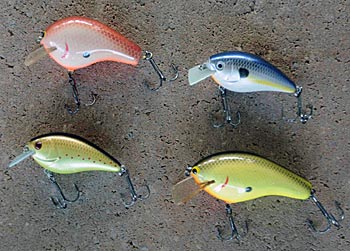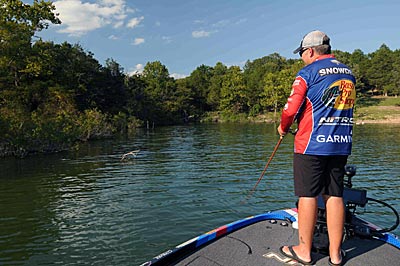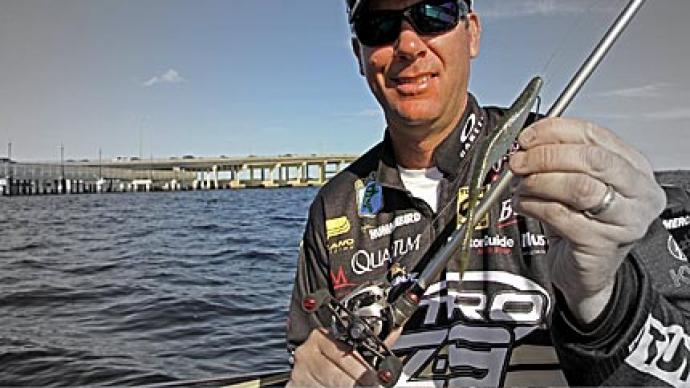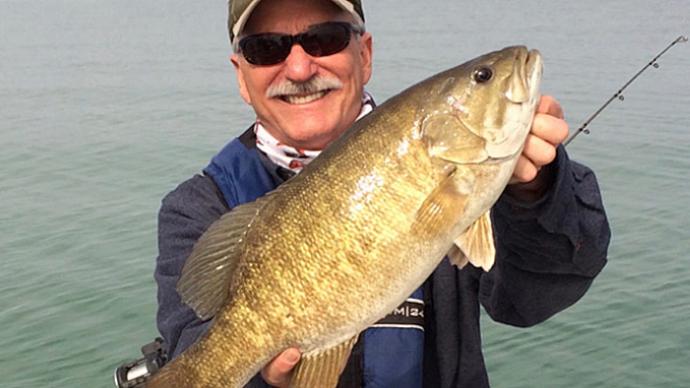
Brian Snowden follows a simple game plan for fishing square bill crankbaits for bass in the fall.
“I have a simple approach to it,” Snowden says. “If it just rocks, I am fishing. I use the classic square bill such as the Azuma (Matt Reed Square Boss) square bill, which runs about 4 or 5 feet with a medium to wide wobble.”
He favors this crankbait because it has a rugged, chip-resistant lip making it more durable than other plastic-lipped square bills. “You can throw it on rocks, run it down riprap, bang it into the docks, and you don’t tend to have any problems with it,” Snowden says. He notices the plastic lips on other square bills wear down when constantly banged into objects, and the crankbaits lose their deflective properties, whereas the Azuma square bill’s lips retain their shape and run through cover better.
When fishing wood cover, Snowden opts for a balsa wood square bill to knock into logs and stumps. “Balsa backs up far better than plastic,” Snowden says. “It is just more buoyant.” The Missouri pro notes balsa square bills, such as the Bagley Balsa B, will deflect and back off the wood cover better and hang up less than plastic square bills. However, he avoids throwing the balsa square bills around rocks and docks because the balsa crankbaits are more fragile than plastic models and tend to crack up when banged into the hard cover.
The Bassmaster Elite Series competitor believes square bills are so effective in the fall because the baitfish move shallower into the creeks and the lures are ideal for running into the shallow ambush points of bass. “The creeks usually have a mixture of laydowns and rocks, and that is what the square bill works real well around,” Snowden says.
Matching the hatch is a key to catching bass on square bills during the fall. He throws the 2 1/2-inch Bagley B most of the time but will opt for a 3-inch Bagley Balsa Pro Sunny B if he is fishing a lake filled with larger gizzard shad.

Snowden throws his square bills on a 6' 10" medium action St. Croix Legend Elite Casting Rod and Bass Pro Shops Johnny Morris Platinum Series baitcast reel (6.4:1 gear ratio) spooled with 17-pound monofilament line. If he is fishing ultra-shallow laydowns, Snowden switches to 20-pound monofilament so his square bills will run less than 3 feet deep. When he wants his square bills to run deeper, he ties the lures on 14-pound fluorocarbon line. Using a shorter rod helps Snowden make more accurate casts to laydowns so he can run his square bills close to each side of the logs he targets.
The best weather conditions for square bill crankbaits depend mainly on water clarity. “The dirtier the water, the more I like it sunny,” Snowden says. “The clearer the water, the more I like it cloudy. You will notice in the fall that the baitfish tend to rise and be more active in the sun than in the clouds.” Some wind is also preferable to Snowden for fishing square bills on sunny or cloudy days.
Water clarity also dictates what color square bill Snowden will throw in the fall. He prefers chartreuse-and-brown, chartreuse-and-black, or sexy shad for stained water and citrus shad or white-and-black for water with less than 1 foot of visibility.
Snowden employs a stop-and-go retrieve when he throws the plastic-bodied Azuma square bill. “If I am not banging the rocks well or coming by the docks and it has left the bottom, I will stop it, pause it, start it, stop it and pause it usually at a medium to medium-fast retrieve,” Snowden says. He will pause the lure for about 3 to 4 seconds every 5 to 10 feet to create an erratic action, but if his lure is constantly banging the rocks, Snowden will occasionally pause it to trigger a strike.
Snowden uses the same retrieval speed for his balsa wood crankbaits but keeps his lure moving the whole time. “I let the wood that it is bouncing off of cause that erratic action,” he says. “The faster and more steady you reel when you come into cover, the less it gets hung. Every time you pause that bait, it flattens out, which means those hooks get more level, and then when you start it up, that’s what causes the lure to get hung.”
By constantly reeling the square bill when it hits the wood, Snowden can keep the crankbait nose down, which causes its bill to run into the wood and protects the hooks from the cover. “I just let the bait bounce off as much of the limbs and branches as I can,” he says.
The six-time Bassmaster Classic qualifier stresses well-placed casts that help keep the lure running within 2 to 3 inches of the wood cover is the key to catching bass on square bills in the fall. He notices the biggest mistakes novices make: throwing across a laydown rather than being patient and getting in position so they can throw to each side of the target. Snowden also suggests it sometimes takes five to 10 casts to the same log to trigger a strike from bass hiding in the cover.
BassResource may receive a portion of revenues if you make a purchase using a link above.




